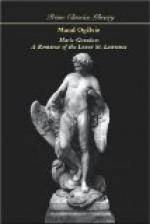What a motley throng it was! Bohemia rubbing shoulders with orthodox conventionality. Duchesses, actors, artists, bishops, newspaper men out at elbows, deans, girl art students, spruce looking Eton boys in tall hats and short jackets, all eagerly pushing their way to the envied goal. A frantic endeavor it was, too. To tell the truth, few of the throng came to see the pictures; most of them, firmly believing that “the proper study of mankind is man,” assembled to view each other. Of course there were some conscientious art critics, but these were few and far between.
The Gallery rapidly filled, and the guests by degrees formed themselves into little groups.
Four or five men of the most Bohemian type were gathered in front of a large canvas hung on the line, an enviable position. They were all foreigners, and were attracting much attention by their shrill voices and gesticulations. “Yes,” said one, a little Frenchman, “I know he’s not an Englishman, no Englishman ever painted like that. No, I should think not. The tone, the purity, the—the——”
“No, he’s not an Englishman,” said a representative of the British nation passing just then, and pausing to take up the cudgels for his country. “He’s not an Englishman, but I don’t like your prejudice; he’s not a Frenchman either, for that matter, so you can’t claim him.”
“What is he, then?” demanded the little Frenchman.
“He’s a Canadian.”
“Canadian, ah! What’s his name?”
“Lacroix.”
“Oh! he’s half French at any rate,” said the little artist triumphantly, “and I know he studied in Paris. Well, this is a masterpiece I know, no matter who painted it.”
The picture which had caused so much discussion was a very large one, covering some five feet of canvas. In the foreground was a long sandy road, on which was a procession of all manner of vehicles of different kinds. Hay-carts, calashes, buck-boards, and rude specimens of cabs were being driven by French-Canadian habitants along the road. In the middle distance was a churchyard crowded with people, most of them looking very ill, and many of them leaning on crutches. The invalids seemed to be attended by their relatives or friends, whose strongly-knit frames and sun-burned faces contrasted vividly with those of the pilgrims.
The wonderful thing about this picture was the distinct manner with which each of the many faces was brought out on the canvas. In a marvellous way, too, the interior of the church just beyond the graveyard was portrayed. Through the door, flung widely open, and crowded with an eager multitude, could be seen the High Altar, the candles brightly burning in honor of the Holy Sacrament, and at the rail were lines of pilgrims awaiting the approach of the officiating priest.
The priest, an imposing figure clad in the gorgeous vestments of the Roman Catholic church, was bending down and allowing the worshippers to touch a relic of the Good St. Anne, in whose miraculous power of healing they so firmly trusted.




